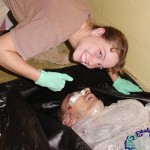Just in case anyone was in any doubt:
Torture has been prohibited for many, many years. The key document today that prohibits torture is the United Nations Convention Against Torture, and international treaty that almost every country in the world, including the United States, has ratified. The Convention Against Torture says that under no circumstance can torture be used: it is an international crime, and every country in the world must pass legislation to make it a crime. […] Torture is also prohibited by customary international law – that is law that has arisen by the practices of nations. It is an absolute prohibition: under no circumstance can you torture anybody, ever. […] Nor does the Convention Against Torture permit any excuses for torture. Article 2 says that “no exceptional circumstances whatsoever” – whether a state of war or a threat of war, political instability, or any other public emergency – may be evoked as a justification of torture. It goes on to say that an order from a superior officer or a public authority may not be invoked as a justification for torture. That is an illegal order, and you can be punished as a criminal for carrying it out.
The convention is crystal clear: under no circumstance can you torture people, whatever you call them, whether illegal combatants, enemy combatants, murderers, killers. You cannot torture anybody ever; it’s an absolute prohibition.
Michael Ratner, Guantánamo: what the world should know (Arris Books, 2004) 31-32
More directly, it must involve continuously reaffirming why torture is never acceptable under any circumstances, even as a limited warrant for exceptional situations. There are a great many powerful arguments to make in support of an absolute prohibition on torture, including: by nature torture is a unique kind of wrong – a form of rape that perverts human relationships and agency – that cannot therefore be morally justified under any circumstances; torture violates the principle of non-combatant immunity, which is the same reason why terrorism is morally wrong; torture leaves permanent damage to both the tortured and the torturer, and thus, is morally indefensible; the ‘ticking bomb’ scenario is a highly flawed thought experiment with virtually no real-world relevance; torture is a very poor tool of intelligence-gathering and can even be counter-productive; sociologically and historically, exceptions to the prohibition on torture have always led to its widespread use in non-exceptional cases and have undermined the moral community and the respect for human rights more generally; and its formal legal adoption by a democratic society, as advocated by Alan Dershowitz for example, would entail moral practices that are incompatible with liberal norms and rights, such as torture-training for interrogators and doctors, medical support for torture sessions, research and development in non-lethal torture and the manufacture of torture equipment and torture facilities, among others. (370)
Richard Jackson, Language, policy and the construction of a torture culture in the war on terrorism Review of International Studies (2007), 33, 353–371
This concept of homo sacer allows us to understand the numerous calls to rethink the basic elements of contemporary notions of human dignity and freedom that have been put out since 11 September. Exemplary here is Jonathan Alter’s Newsweek article ‘Time to Think about Torture’ (5 November 2001), with the ominous subheading: ‘It’s a new world, and survival may well require old techniques that seemed out of the question.’ After flirting with the Israeli idea of legitimising physical and psychological torture in cases of extreme urgency (when we know a terrorist prisoner possesses information which may save hundreds of lives), and ‘neutral’ statements like ‘Some torture clearly works,’ it concludes:
“We can’t legalise torture; it’s contrary to American values. But even as we continue to speak out against human-rights abuses around the world, we need to keep an open mind about certain measures to fight terrorism, like court-sanctioned psychological interrogation. And we’ll have to think about transferring some suspects to our less squeamish allies, even if that’s hypocritical. Nobody said this was going to be pretty.”
The obscenity of such statements is blatant. First, why single out the WTC attack as justification? Have there not been more horrible crimes in other parts of the world in recent years? Secondly, what is new about this idea? The CIA has been instructing its Latin American and Third World military allies in the practice of torture for decades. Even the ‘liberal’ argument cited by Alan Dershowitz is suspect: ‘I’m not in favour of torture, but if you’re going to have it, it should damn well have court approval.’ When, taking this line a step further, Dershowitz suggests that torture in the ‘ticking clock’ situation is not directed at the prisoner’s rights as an accused person (the information obtained will not be used in the trial against him, and the torture itself would not formally count as punishment), the underlying premise is even more disturbing, implying as it does that one should be allowed to torture people not as part of a deserved punishment, but simply because they know something. Why not go further still and legalise the torture of prisoners of war who may have information which could save the lives of hundreds of our soldiers? If the choice is between Dershowitz’s liberal ‘honesty’ and old-fashioned ‘hypocrisy’, we’d be better off sticking with ‘hypocrisy’. I can well imagine that, in a particular situation, confronted with the proverbial ‘prisoner who knows’, whose words can save thousands, I might decide in favour of torture; however, even (or, rather, precisely) in a case such as this, it is absolutely crucial that one does not elevate this desperate choice into a universal principle: given the unavoidable and brutal urgency of the moment, one should simply do it. Only in this way, in the very prohibition against elevating what we have done into a universal principle, do we retain a sense of guilt, an awareness of the inadmissibility of what we have done. (Slavoj Žižek On torture and terrorism)
Moreover, I am again tempted to conduct a simple mental experiment: let us imagine an Arab newspaper making the case for the torture of an American prisoner – and the explosion of comments about fundamentalist barbarism and disrespect for human rights this would provoke! (Slavoj Žižek Welcome to the Desert of the Real, 104)
It is as if not only the terrorists themselves, but also the fight against them, now has to proceed in a gray zone of legality. We thus have de facto “legal” and “illegal” criminals: those who are to be treated with legal procedures (using lawyers and the like), and those who are outside legality, subject to military tribunals or seemingly endless incarceration.
Mr. Mohammed has become what the Italian political philosopher Giorgio Agamben calls “homo sacer”: a creature legally dead while biologically still alive. And he’s not the only one living in an in-between world. The American authorities who deal with detainees have become a sort of counterpart to homo sacer: acting as a legal power, they operate in an empty space that is sustained by the law and yet not regulated by the rule of law. […]
In a way, those who refuse to advocate torture outright but still accept it as a legitimate topic of debate are more dangerous than those who explicitly endorse it. Morality is never just a matter of individual conscience. It thrives only if it is sustained by what Hegel called “objective spirit,” the set of unwritten rules that form the background of every individual’s activity, telling us what is acceptable and what is unacceptable.
For example, a clear sign of progress in Western society is that one does not need to argue against rape: it is “dogmatically” clear to everyone that rape is wrong. If someone were to advocate the legitimacy of rape, he would appear so ridiculous as to disqualify himself from any further consideration. And the same should hold for torture.
(Slavoj Žižek, Knights of the Living Dead, NYTimes.com March 24, 2007 – also available here)












